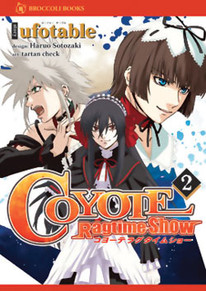Review
by Carl Kimlinger,Coyote Ragtime Show
GN 2
| Synopsis: |  |
||
On their way to the soon-to-be-destroyed Planet Graceland, Mister and his coyote buddies (coyote being a term referring to outlaws, not scruffy animals that feast on garbage) stop off to pick up one of Pirate King Blues' ex-comrades. Swamp is a pirate-turned-preacher with a stupid name, a spectacular mane, and a nasty grudge against Mister. Mister wants him to help in the recovery of the treasure Blues hid on Graceland, but will have a heck of time convincing him to come along peacefully. Elsewhere Madame Marciano takes time between massacres to reminisce about the time when she led a pack of street urchins and got beat up for bottles of wine. Before she can take on Mister she and her twelve killer loli-goth androids must first massacre the remnants of the guild, while Mister must deal with persistent police bloodhound Angelica. It's all a terrible pain, but everything is in the name of coyote pride and boatloads of cash, so naturally they suck it up and deal with it. |
|||
| Review: | |||
It would be nice to say that Coyote Ragtime Show is an exception to the rule that says that manga adaptations of anime properties are always rushed sub-par rehashes, if only because it would be nice to say something different for a change, but it isn't. And this manga adaptations has the additional drawback of being a rushed, sub-par rehash of a series that was, to put it delicately, crap to begin with. Set in some bizarre alternate universe where outlaws are brave, principled iconoclasts rather than scruffy animals that feast on garbage, Coyote Ragtime Show was already a rehash of other tales of brave, principled iconoclasts well before it was compressed into a handful of volumes and retold minus the stellar production values that kept the original at least moderately watchable. The paper version bogs down the action and derring-do with cheap drama a la Marciano's "tragic" backstory and smug philosophizing about the "coyote way" (who knew that outlawry actually makes a person more moral?). In other words, not that different from the animated version, just with all of it crammed so close together that no scene has time to sink in and each chapter has about a half-dozen too many self-satisfied Mister-grins. Even for fans of light heist/action tales this book is too crowded and preachy to be enjoyable, and for fans of genre innovators like Sam Peckinpah and Kinji Fukasaku who spent their lives demythologizing junk like this, it'll be pure torture. Appropriately enough, the manga's art clearly outclasses its story. The art is clean, with a detailed yet spare feel to it; full of good-looking characters (Mister excepted) and simple, minimalist compositions. Layouts are straightforward and rectangular, easy to follow without feeling stodgy or rule-bound. The panels are filled with lots of nice, solid blacks and the characters are drawn with simple, anime-friendly lines. To be sure, the space strictures that come with cramming so many plot points into so few books drain the action scenes of any expansive cinematic panache they may have had and force the illustrators into crowding some pages more than is pleasing to the eye, but the art's only real flaw (Mister excepted) is how poorly the dialogue bubbles are integrated into the artwork. Broccoli Books is one of the yardsticks with which to measure other manga titles. Glossy color title pages, beautiful printing, paper whose quality is apparent just from the heft (their books make handy self-defense weapons at crowded bus stops), sound effects left in Japanese with nearby translations, and plentiful extras. Included in this volume is a lengthy extra chapter in which the characters fight over who gets the lead role (and kill the animators in the process), foot notes, production sketches, translation notes, and a relationship chart for Marciano's 12 "daughters." Also included are translated previews for the next Coyote Ragtime Show volume and for the first volume My Dearest Devil Princess, a series that appears to be some form of exquisite moe torture. Horning ten hours of anime into few measly books means laying on the plot developments thick and heavy. But confusion isn't the real enemy. The real enemy is when all of those plot points pass by and yet it seems like nothing at all has happened. Because then you know that the plot is slipping out the back door of your brain as quietly as it entered, and leaving no trace as it leaves. Outside of the imprint of Mister's smug grin on your retina, which, believe me, everyone can do without. |
|
The views and opinions expressed in this article are solely those of the author(s) and do not necessarily represent the views of Anime News Network, its employees, owners, or sponsors.
|
| Grade: | |||
Overall : C-
Story : C-
Art : B
+ Clean, attractive art (Mister excepted), excellent presentation. |
|||
| discuss this in the forum (1 post) | | |||
| Production Info: | ||
|
Full encyclopedia details about Release information about |
||